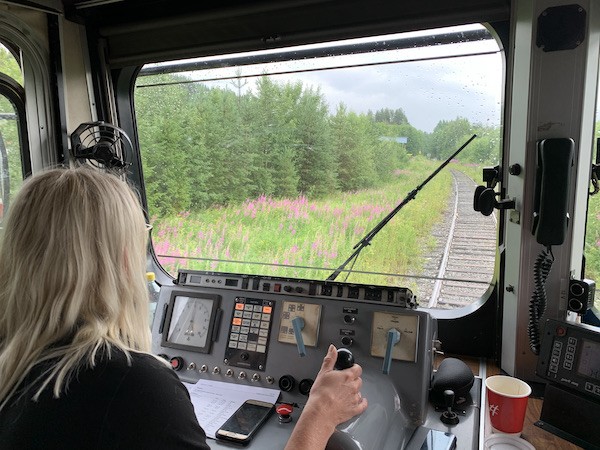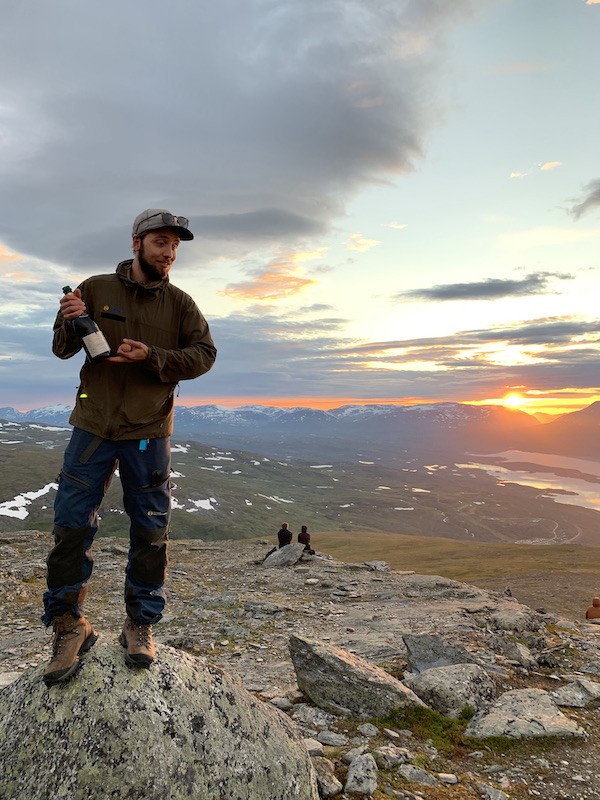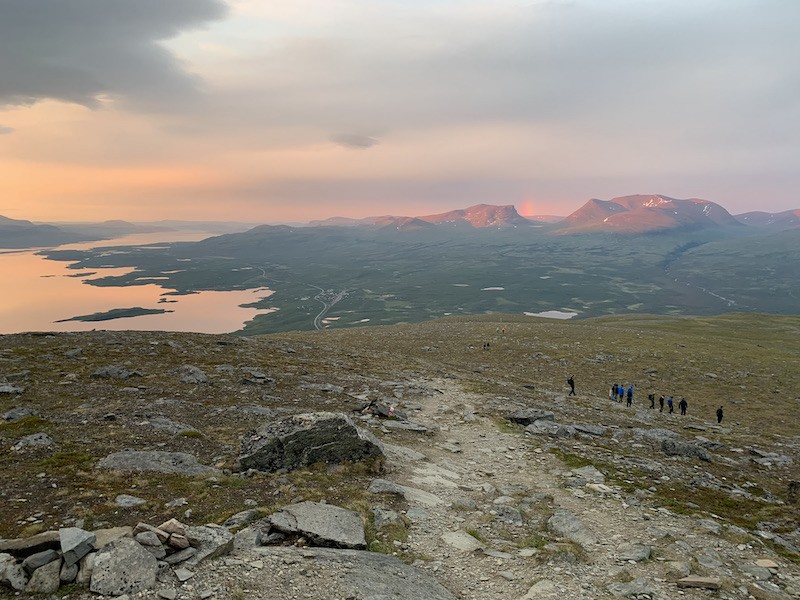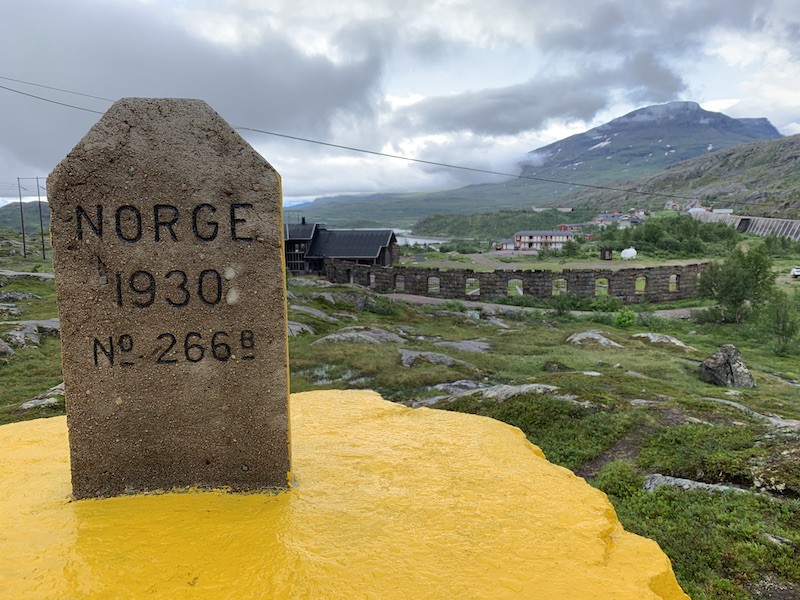Often described as Europe’s last wilderness, Sweden’s remote and sparsely populated far north is a land of striking beauty – and in summer it’s easy to visit without a car or plane. The slow trains of the Inlandsbanan, or Inland Line, take you through a landscape of forests, heathland, lakes and rivers. On the way, reindeer and elk cross the tracks. Ahead of you, over a thousand miles of wild nature and endlessness. Welcome to life in the slow lane.


A look of fear flashes across Åsa’s face. From the passenger compartment, she peers through the glass at a group of reindeer calmly making their way onto the tracks. Despite the screeching sound of the driver’s whistle, the animals seem unfazed and the train comes to a slow halt in the middle of the Swedish wilderness…
It’s July and we’re on our way to Riksgränsen, a village located north of the Arctic Circle on the border of Sweden and Norway. We’re traveling with an Interrail Pass. From Stockholm, it’s around 1,000 miles through the heart of the country, all the way into Swedish Lapland. The land of the midnight sun, the northern lights and the Sami people. Three train connections are needed to cover the distance: the first, an Intercity that shuttles us 200 miles from Stockholm to the town of Mora. There, we hop onto the famous (and immensely popular) Inlandsbanan, which drops us off in Gällivare, Lapland, some 700 miles later. The final stretch we spend on the Malmbanan, the legendary Iron Ore Line, all the way to the border: Riksgränsen. (Due to covid-19 restrictions, it was not yet possible to travel further to the end of the Iron Ore Line in Narvik, Norway).
Today, the first 130 miles of the Inlandsbanan are electrified, and passengers are whisked through the countryside on fast, modern trains. From Mora on, it gets a bit more adventurous, with 40-year-old former SJ diesel trains of Italian manufacture travelling at an average speed of 30 mph. Welcome to life in the slow lane.

Inlandsbanan
Running for almost 800 miles from Kristinehamn in the central province of Värmland to Gällivare in the north, the Inlandsbanan, as the name suggests, passes straight through Sweden’s interior. The idea to build the railway was first floated in the late 1800s, but it would take another 30 years for the line to be completed. Behind its construction were both defensive and economic motives. A railway which crossed the more impenetrable inland areas of Sweden would, it was thought, be much easier to defend than a railway along the coast. It would also link the country’s less populated north, with all its precious raw materials, with the commercial hubs of the south, and the inevitable promise of economic growth was too hard to resist.
Construction, however, would prove no mean feat, with an almost impassable interior of forests, marshland, hills, rivers and valleys standing in the way. The landscape forced the builders around every bend, and required no less than 250 bridges and many miles of extra steel to reach its final destination.
Remarkably, it was the Germans who profited most from the railway after its completion in 1937. Sweden, officially neutral, allowed the Nazis to transport troops and military equipment to Norway, Finland and the northern Soviet Union – and in the early 1940s, two million German soldiers used the Inlandsbanan to get to the front, up to 12,000 men each week.
But in the 50s and 60s, the line entered a period of steady decline. Car ownership was on the rise, and a national highway was built almost parallel to the railway, leading to a drastic fall in the number of passengers. Service reductions and line closures ensued. The final death knell sounded in 1992 when SJ, Sweden’s national railway, declared the line financially unviable.


Cosy living room
In 1993, in a bid to revive the Inlandsbanan, 15 Swedish municipalities along the route joined forces and founded the private company Inlandsbanan AB, which today runs the line and its four trains. For ten weeks a year, from mid-June to the end of August, the Inlandsbanan runs once a day, carrying tourists and adventure seekers across the Arctic Circle and into Lapland, one of Europe’s last wildernesses. With no more than 60 seats, the train has an almost cosy feel, like you’re sitting in someone’s living room – a feeling only enhanced by the conductor who regales passengers with anecdotes about Sweden and the Swedish landscape. About the reindeer that regularly cross the tracks, the beavers damming a stream, or fun facts about the train line itself. On our journey, it’s Åsa, Isabel and Pär, train staff you begin to know by name after so many hours together. After our train grinds to a halt to avoid a nasty incident with some passing reindeer, Pär informs us that it won’t be the last time the train has to stop in the middle of nowhere. With over 250,000 wild reindeer in Sweden, emergency stops are a regular event – and one that doesn’t always end so well for the animals, when they spring onto the tracks unexpectedly.




Stop requested
Originally, there were around 200 stations and stops along the line, and more than 200 waiting cabins, but most of these have now disappeared altogether, been shut down or repurposed. Today, passengers can board and disembark at 29 official stations. In between these are a number of other places where the train only stops if someone indicates from the platform, and it’s actually only possible to get off if the train stops to pick someone up. Along the route there are also a number of special stops, including at the Arctic Circle, where you can jump out to stretch your legs, get some fresh air and get that photo for Instagram.
Naturally, some people ride the Inlandsbanan to get from A to B, but we, like most travellers, make a real rail trip out of it, and get off several times along the way. This way you not only experience the romance of travelling by train, but you also grab every opportunity Lapland has to offer – and in this vast wilderness, the possibilities for adventure are endless. From any station you can walk straight into nature, and thanks to Sweden’s right of public access (Allemansrätten), you can wild-camp anywhere. Ahead of us, we have seven stops planned.
Mora
Our first stop is Morastrand on the banks of Lake Siljan, created millions of years ago by a meteorite impact. It’s home to Sweden’s highest waterfall, Njupeskärhet (93 metres), the Mora Hotel, the city’s oldest hotel since the opening of the railway line, and the famous Dalahäst, or Dala horse – a traditional carved horse that’s hugely significant to Swedish culture and identity. In Nusnäs, a half an hour’s bike ride from Mora, we see with our own eyes how the world’s most famous wooden horse is crafted. The tradition dates back to the 18th century when forest workers from the region whiled away the long winter months by carving horses. What was intended as a toy for their children grew into an icon that has now become a symbol of Sweden. Partly thanks to the brothers Nils and Janne Olsson, who took a huge Dala horse to the World Fair in New York in 1939 and garnered world fame. Today, 120,000 pieces are made annually, and each one is unique.





The red and white train is already waiting for us when we get back at the hotel. Departure: 1:25 PM. And you’d better be on time, because the train only runs once a day. And so we set off for Östersund, 200 miles further north, and a 5-hour journey without changing trains. Outside, the forest flashes by. We open the windows for some fresh, oxygen-rich air. Here and there, we see typical Swedish faluröd houses (wooden cottages painted in red) which dot the landscape. The further north we go, the rarer the houses and the more the forests colour the countryside green.
Thankfully, we’re not bored for a moment; the enthusiastic guide-cum-conductor takes care of that. Besides checking tickets and telling stories, Isabel introduces us to fika, a uniquely Swedish ritual that combines slowing down, having coffee and cake with your friends, and generally getting back in touch with the people around you. A song comes on over the speakers; its name, Koppången, inspired by the area we travel through after leaving Mora. As the compartment fills with the sound of violin, a sea of purple flowers passes us by, which, our guide informs us, are said to have medicinal properties and are picked by locals to make lemonade.
We notice a few water pumps in the middle of the forest – installed, Isabel tells us, by the Germans, who didn’t want their trains to stop in villages for fear that soldiers would flee. We learn about how the German transportation of troops and ammunition took place amid the greatest secrecy, with the ammunition hidden under tarpaulins. And that the enormous, infamous German railway gun, the ‘Schwere Bruno’, was transported along the line to Norway disguised as ‘bridge-building material’.



Birch wine
As the train pulls into Östersund, clouds gather overhead and the first drops begin to fall. It feels like we’re already way up north, but appearances can be deceiving. Östersund is only halfway up Sweden, and long stretches of countryside still lie ahead of us. But it’s the last city before we enter the emptiness of Lapland. The only train heading north leaves at 7.40 AM, so we plan an extra night here to explore the town.
Östersund has been declared a City of Gastronomy by UNESCO, and this is something instantly discernible. The small city at lake Storsjön is full of entrepreneurship and cool gastronomic concepts. Some local industry-leaders have managed to create authentic culinary experiences, great bars and courtyard clubs. The tidy town centre is brimming with restaurants and coffee bars, including the recently opened Norra Station, a café, roastery, gallery and co-working space, all wrapped up in one. Owner Manne Mosten has been organising cultural and gastronomic walks through the city for over ten years and is full of stories. He tells us about Peter Mosten, a local man who found a 1785 recipe for birch wine in an old archive and breathed new life into it. The juice for this birch wine is extracted by hand from the forests around Östersund and then slowly fermented into wine, which is now sold under the name Sav Glöd.
First Swedish ‘hotel’
The next morning, we continue our train journey to Storuman, the first stop in Swedish Lapland, a five and a half hour train ride away. We pass a former prison in Ulriksfors “once intended for light criminals who could walk in and out freely,” says our guide, “which is why it was also called Sweden’s first ‘hotel’.”
On the way, the train makes a surprising 50-minute pit stop at Vilhelmine Norra station. The reason? A local restaurant, Bergmans, has something fresh on the menu: arctic char, a salmon-like fish caught locally.
100 years ago there were just some farmers ruling Storuman, and only when the Inlandsbanan connected the village it became an important centre for hydroelectric power and the timber industry. Today it is a hideway for those seeking a remote, calm holiday experience, in a stunning scenery with mountains and secluded lakes and islands.
A brief 10-minute walk from the impressive wooden station at Storuman, which dates back to 1916, we find Storumans Camping, a lakeside campsite. Here you can spend the night in a giant kåta, or Sami hut. But we take the comfier option: a relaxing log cabin by the water. We grab our bikes and climb up the Stenseleberget hill along Björn Ferry Road, named after the famous biathlete and world champion from this region. The climb is tough, but at the top we’re treated to views of Norwegian mountain peaks and a café, Utsikten, with Swedish delicacies to soothe our aching legs. We order kolbulle, a type of Swedish pancake that was once baked for the railway workers. Another highlight are the crispy Swedish waffles with hjortronsylt, or cloudberry jam. Also known as the ‘gold of the north’, these golden-yellow berries, similar to blackberries, grow in the wild and are often used in Swedish desserts.



Fined 3,000 krona
From Storuman we continue our journey northwards, direction Jokkmokk. This is the longest part of our journey: six and a half hours, 200 miles. We cross Lapland, a land characterised by vast birch and pine forests, marshes, fens and heathlands. This is the land of the Sami, who live here in nature with their reindeer. We cross a number of rivers, which run from the Scandinavian mountain ranges to the Baltic Sea, and pass Sweden’s smallest railway station in Buddnakk, which is no more than a shed.
A few miles south of Jokkmokk, we cross the Arctic Circle. The location of the parallel is marked on both sides of the route with white-painted stones, white posts and a large sign – “although these are not entirely correct,” our guide explains. “The Arctic Circle shifts a few metres every year.”
Suddenly we hear the screeching sound of the train horn. In the distance, dozens of reindeer graze peacefully on the tracks, and the honking does little to deter them. The train driver inches towards them, even stopping at one point. Only when the reindeer leave the track does he set the train in motion again. “You have to be on your guard all the time,” he says. “We see all sorts here. Last week we spotted a lynx, and sometimes you get bears. Most animals run away, but reindeer are neither wild nor tame. They have an owner.” As it turns out, the railway company must pay the Sami some 3000 crowns (almost £250) if a reindeer is accidentally run over.



Solitude
It’s gone 8 PM when we pull into Jokkmokk, but judging by the light it feels like noon. At this time of year, the sun only sets here for two hours each night. We’re the only travellers who get off here, and as soon as the train disappears from sight, a silence falls over us. Jokkmokk Municipality has only 5,000 inhabitants spread out across some 10,000 square miles, almost half the size of the Netherlands. Only now do we realise the insane distances we’ve travelled.
Jokkmokk is a natural meeting place for Sami people. Since 1605 the colourful Jokkmokk market has been attracting thousands of international visitors. Today it’s an idyllic laponian town and ultimate hub for outdoor activities in the surrounding nature, like husky-tours, fat tire bike tours, river boarding, hiking, survival camping, hill climbing… everything in an quiet and empty, yet impressively beautiful setting.
A sense of emptiness and solitude; that’s exactly what Björn, the owner of the Peace & Quiet Hotel, wants his guests to experience. The local entrepreneur has had an eventful life. For the last 11 years, he’s spent 200 days of the year living in the wilderness, as a mountain guide in Austria and a trainer in the Special Forces. “I taught soldiers to survive for 24 hours alone in the forest. After that, I wanted ‘normal’ people to be able experience this same sort of soft adventure. That’s how I came up with the idea of a hotel with comfortable cabins floating on a wooden raft in the water, surrounded by the untouched wilderness of Swedish Lapland.”





The Iron Ore Line
From Jokkmokk, it’s another one and a half hours to the end of the Inlandsbanan, and our destination for the night: Gällivare. But after a packed day – a morning dip in the river, off-road biking through the mountains, and wild swimming in the River Pärlälven – it’s a relief to only be spending the night here. Grand Hotel Lapland is conveniently located right next to the train station, and our muscles get some much needed R&R in the jacuzzi on the roof terrace – with beautiful views on Dundret mountain.
The next morning, we board the Malmbanan, the legendary iron ore route that connects the coasts of Norway and Sweden, from Narvik in the west to Luleå in the east. In between the two lies Kiruna, Sweden’s northernmost city, and a place with an intriguing history. Founded by miners in 1890, Kiruna is home to the largest iron ore mine in the world – and the town owes its fortunes to it. Yet the bringer of the town’s fortunes is also the source of its woes, as it was recently discovered that Kiruna is, slowly but surely, sinking into its own mines. Consequently, it was decided to demolish most of the town and relocate it 2.5 miles down the road. An operation that would take at least another ten years. As early as the 17th and 18th centuries, the existence of iron ore in these remote parts was known about, in particular by the Sami. The challenge was transporting this ‘wealth’ to the more inhabited areas down south. For years, this was done by various means, including reindeer and boats – until the Iron Ore Line was opened in 1902, which could transport the iron gold by rail to the harbour in Narvik. To this day, the line is still mainly used for transporting iron ore and the sight of 800-metre-long iron ore trains passing by during your stay is not unusual. But this train does have one silver lining: it opened up this remote area to tourists.

The gate to Lapland
After Kiruna, the railway follows the southern shores of the magical glacial lake Torneträsk for 30 miles or so. On board are lots of hikers who jump off at Abisko to wander for days through the Abisko National Park, following the famous Kungsleden or King’s Trail. This former supply road, built during the construction of the railway, is now used as a hiking trail. We also get off: hiking under the midnight sun is high up on our bucket list – one of the many options and trails you can follow from the convenient Abisko Turist station.
Abisko, about 150 miles north of the Arctic circle, offers probably the most stunning scenery of Sweden. Majestic mountains frame the beautiful Abiskodalen valley with its flowering alpine meadows, picturesque rapids and Scandinavia’s largest alpine lake – Torneträsk. During the summer you can see the midnight sun for several weeks.
A chair lift takes us to the Aurora Sky Station, at an altitude of 900m. From there, we walk to the top of Mount Nuolja at 1164m. It looks like a piece of cake, but beware, there are many ‘fake tops’ here, warns our guide Anders. After a few hours of walking, we reach phenomenal views of Torneträsk, Lapporten (the ‘Gateway to Lapland’) and the Norwegian mountains in the distance. “120 years ago, when the railway opened, people would come all the way from Stockholm for this same experience,” Anders says. “But back then there was no cable car so the trip took more than two days. For many, it was the highlight of their lives, so they’d walk up in their best clothes, in fancy suits and dresses.”




Final destination: Riksgränsen
The last leg of our journey takes us to the border with Norway and…Riksgränsen, our final destination, and an outdoor mecca for hikers, mountain bikers and kayakers, and in winter, skiers. It’s also where the huge iron ore locomotives used to be maintained and refuelled with water and coal. In 2018, the old locomotive depot was transformed into a hotel, the Niehku Mountain Villa (niehku means ‘dream’ in Sami), with the old semi-circular wall of the station running through parts of the new building. Both the exterior and the interior are inspired by the old workshop. The combination of natural materials and colours, as well as references to the culture and tradition of the indigenous Sami people, make this hotel a great base for the many trails that start here. And there’s even a wine cellar with over 500 bottles, located in an old inspection pit. Truly no better place to end our rail trip in style, a journey which at times seemed endless, but was also incredibly comfortable and relaxing.





Our return journey is (un)fortunately a lot faster. From Riksgränsen, a direct night train takes us back to Stockholm –18 hours in one go – and from there we train it back to the Netherlands via Copenhagen and Hamburg, which takes us another 16 hours.




Fast Facts
Starting point: Stockholm
Pit stops: 6x, in Mora, Östersund, Storuman, Jokkmokk, Gällivare, Abisko
Final destination: Riksgränsen
Travel time: Minimum travel time is two weeks, three weeks is ideal. The distances are enormous and there are many stops along the way where fans of the outdoors can indulge themselves. It’s also possible to hike certain stretches.
Travel period: June, July, August. The Inlandsbanan trains only run in summer (for 10 weeks). One train a day departs from each destination and you need a reservation, so you need to plan ahead. In Sweden you can wild-camp, but remember: it’s also the season for mosquitoes, which in Lapland are often plentiful.
Train tickets: You can buy single tickets, but there are other passes that make rail travel easy and affordable. We travelled with an Interrail Global Pass, valid on all trains in Sweden as well as the train journey from the Netherlands to Sweden and back. The 10 day travel pass (10 flexible travel days within 2 months) is €401 and you can also use it if you want to continue your journey on the Iron Ore Line to Norway, for example.
More information: inlandsbanan.se, sj.se, interrail.eu
Special thanks to Henrik Tidefjärd & Sverige Agenten for organising and finding the best stopovers en route.


This has inspired me for my next journey, thank you for taking the time
I remeber when you were on the Inlandsbanan train and shooted a lot of photographs. nice to read about it afterwards. Unfortunately you coldn´t travel along the scenic route between Riksgränsen and Narvik.